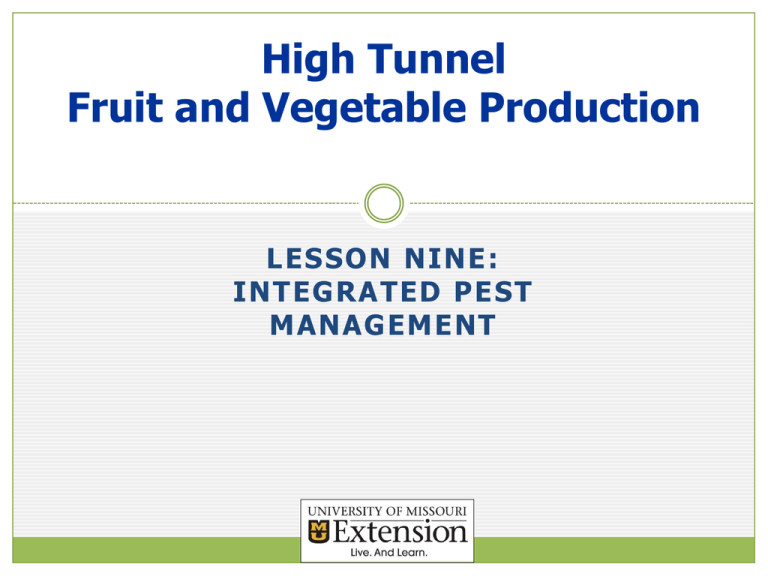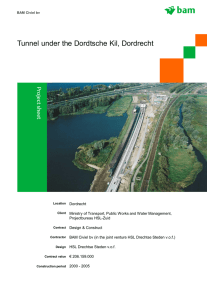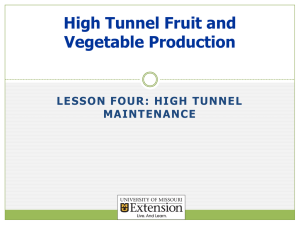PowerPoint - University of Missouri Extension
advertisement

High Tunnel Fruit and Vegetable Production LESSON NINE: INTEGRATED PEST MANAGEMENT Objectives Identify the components of integrated pest management. Recall the importance of integrated pest management to growers and the environment. Discuss a variety of control tactics available to manage insects, diseases and other pests. High Tunnel and Insects High tunnels create a unique environment May lead to different insect and disease pests than greenhouse or field production Even with these differences, the generalities of Integrated Pest Management apply Integrated Pest Management Commonly known as IPM Common-sense, holistic approach Uses knowledge of plants, pests, and the environment sensibly to reduce number of pests. Reducing pests before unacceptable damage is done Uses a combination of control tactics Prevention Monitoring Control Techniques Prevention Use knowledge of past and potential pests to avoid future problems Prevention Activities: Choose resistant and adapted species when available Plant according to best management practices Plant disease- and pest-free transplants and seeds Use sanitation practices Irrigate and use mulch to minimize plant stress Fertilize according to need Monitoring Inspection, detection and scouting Find pests and diseases early Use of trapping devices and visual inspection Provides information to aid in pest control decision- making process Inspect plants in high tunnel at least twice a week Count pests Specific Take locations and specific plant parts good notes and observations Pest, crop, number found and stage of insect growth Control Techniques Four different types of control techniques Cultural (Prevention Techniques) Biological Mechanical (or Physical) Chemical The four management tactics can be used alone or in combination Ultimate goal is to reduce or prevent pest injury Control Techniques: Cultural Horticultural practices that limit pest populations or reduce the amount of damage that pests might cause Essentially the same as prevention measures Control techniques include: Maintaining plant health Making proper plant selections Choosing resistant varieties Using crop rotation Other practices that maintain healthy, vigorous plants Control Techniques: Biological Also known as bio-control Uses living organisms to suppress or limit pest populations Keeps populations down, does not eliminate pests Low level of injury expected Acceptability depends on tolerance level Use of “natural enemies” Organisms that attack pests Three categories: Predators, Parasitoids, Pathogens Control Techniques: Biological Two main ways to use biological controls Augmentation Release of specific beneficial organisms for control of existing pest population Conservation Conserves natural enemies that are already present Reduce use of broad-spectrum pesticides Pathogens Microorganisms: Bacteria, Fungi, Viruses, Nematodes Weaken and kill pests by creating disease or infection Control Techniques: Mechanical/Physical This control method separates the pest from the crop by means of a device or action Actions: Handpicking pests directly from plants Forceful water sprays to dislodge aphids Pruning to remove diseased or infested plant material Install insect screening over vents and side walls Excludes larger insects Control Techniques: Mechanical/Physical Screening reduces airflow, increases temperatures Often overlooked when growers are unaware May reduce airflow by 5-10% with active ventilation May result in 45% ‘wind reduction’ in passively ventilated tunnels – raised air temperature of ~5°F Increase in temperatures could be partially offset by using peak vents or exhaust fans Control Techniques: Mechanical/Physical Screening Standard window screening is an economical choice Must be cleaned occasionally Does not completely restrict influx of pests, reduces Needed pollinators must be introduced and maintained Biological controls that are naturally occurring outside the tunnel will be restricted from entering Not all mechanical controls are effective Ultrasonic and electromagnetic devices Bug zappers Insect traps (yellow sticky cards) Control Techniques: Chemical Use of pesticides, naturally occurring or synthetic Adversely affect unwanted insects, weeds or plant pathogens Affect plant growth Repel insects from an area Judicious use in combination with other tactics Or, if other tactics do not give desired level of control Thoughtfully chosen and properly timed application Least toxic alternatives Consider use of “soft” or “reduced risk” compounds Consider environmental consequences Importance to Growers IPM practices must be compatible with objectives Practices must be: Economically viable Effective Understandable Practices can be implemented in stages Importance to Growers Approach should improve grower’s profitability and reduce risk of crop loss Monitoring used to determine economical timing Provides greater peace of mind High tunnel production is large investment Proper field scouting for informed decisions Importance to Environment All practices must be environmentally sound Benefits received from control vs. risks of that control should be considered before practice is developed Reduces unnecessary pesticide applications Pesticides are generally largest environmental concern with pest management Fewer unwarranted pesticide applications such as “calendar sprays” High Tunnel Insect Control Major insect and mite pests of high tunnel crops should be given consideration Avoid having lights on in evening or night near or inside the high tunnel Security lights or lights for convenience Lights attract a range of insects, particularly moths These insects may inadvertently cause crop damage High Tunnel Insect Control Hornworms/Other Caterpillars of Tomato & Peppers Damage usually occurs from midsummer to fall Eat irregular holes in leaves and may defoliate plants Camouflaged – often difficult to see Fruitworms Feed on green fruit Damage is deep watery cavities on stem end of fruit Inspect tomato plants for larvae on fruit and leaves Threshold in high tunnel is one caterpillar Can be handpicked or use insecticide sprays High Tunnel Insect Control Whiteflies Tiny, resemble tiny white moths Disperse from plants when disturbed Most common on tomatoes and melons in late season Damage done when in immature (nymph) stage Suck sap from plant leaves Spread viral diseases Inspect plants for off-color or stunted plants Yellow sticky cards will monitor adults Spray with insecticide/insecticidal soap High Tunnel Insect Control Aphids Migrate into high tunnel from wild hosts Establish colonies on plants Soft-bodied, pear shaped small insects Usually Suck on underside of leaves, may be found on stems sap from plants Leaves curl under, become deformed, weakens plants Can be vectors of plant diseases Scout plants closest to openings Wide range of control options High Tunnel Insect Control Spider Mites Tiny (~.5mm long), live on undersides of plant leaves Puncture plant cells to feed on the sap Speckled “bronzing” discoloration of leaves Reduced plant growth Possible early defoliation and death Thrive in hot, dry weather and are more likely from mid season through fall High Tunnel Insect Control Spider Mites (Continued) Inspect leaf undersides for egg webs, cast skins and all stages Control weeds and practice clean mowing around tunnel to help prevent movement from outdoors Begin treatment when symptoms appear Insecticidal soap or other miticide Miticides do not kill eggs so repeat application should be considered High Tunnel Insect Control Thrips Small (1/16 inch long) and elongated Found in flowers or on the undersides of leaves Damage to plants is caused by adults and nymphs Scrape the surface of leaves with mouthparts and feed on exuding sap Leaves will have small, silver streaks Plants look as though they have been sandblasted High Tunnel Insect Control Thrips (Continued) Early detection is important Frequently inspect blossoms and leaf undersides Sticky traps can detect adult winged thrips Apply systemic, targeted insecticides at transplanting Effective For in controlling for ~35 days on certain crops control, spray contact insecticides High Tunnel Insect Control Cucumber Beetles Same beetles that that will attack field-grown cucurbits Transmit bacterial wilt Can damage high tunnel melons Overwintered adults feeding on transplant leaves and stems can kill small plants Surviving Frequently Reduces plants may be infected with bacterial wilt feed on the fruit surface aesthetic appeal Creates openings for sap beetles and disease organisms High Tunnel Insect Control Cucumber Beetles (Continued) Can be excluded from transplants by using row covers in the high tunnel Systemic insecticides applied at transplanting will provide up to 35 days of control Long enough to reduce bacterial wilt and infection Foliar insecticides provide further control through growing season Avoid No insecticides that may be toxic to pollinating insects effective biological control techniques High Tunnel Plant Disease Control High tunnels can reduce disease impact by: Elevating soil temperatures slightly Enough to prevent common cool weather damping-off and root rots Keeping foliage dry Preventing establishment of most foliar diseases Powdery Mildew can germinate Absence of free water Can be even more serious than in a field-grown crop High Tunnel Plant Disease Control Disease management should include the following considerations: Use plastic mulch combined with trickle irrigation Keeps foliage dry, reduce splash of soil-borne pathogens Maintain humidity to remove excess moisture Provides conditions conducive to certain diseases Use ventilation and follow plant-spacing guidelines Use disease-resistant varieties when possible Always start with disease-free seed and transplants High Tunnel Plant Disease Control Disease management should include the following considerations: Provide optimal growing conditions Proper irrigation, fertilization, staking, pruning, etc. Increase plant health and vigor Practice sanitation to remove and destroy infected plants as they are found Pick produce frequently, cleanly and completely Remove all over-ripe and damaged produce Remove all plant residues at the end of the season Practice crop rotation High Tunnel Plant Disease Control Powdery Mildew Major problem for all high tunnel crops Environmental conditions in tunnel favor development Produces white, powdery colonies On leaves, petioles, and stems of infected plants Usually appears on lower leaves Gradually Plants Fruit spreads through the canopy become weakened from leaf loss size can be significantly reduced High Tunnel Plant Disease Control Powdery Mildew (Continued) Choose resistant cultivars when possible Inspect plants regularly, starting at fruit set Many effective fungicides are labeled for control Includes several synthetic fungicides and organic products, such as mineral oils & potassium bicarbonate Alternate synthetic fungicides to prevent the development of resistance







